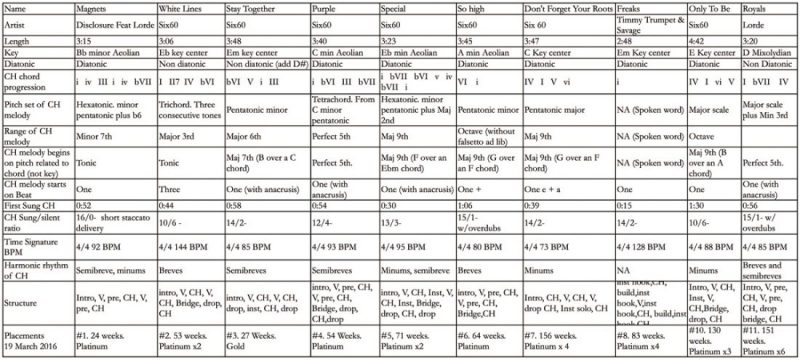X-Factory: Seeking The Secrets Of Top 20 Chart Success
X-Factory: Seeking The Secrets Of Top 20 Chart Success
Looking at the NZ music Top 20 (NZ artists ranked by sales) singles chart recently I couldn’t help noticing that it looked very similar to the Top 20 chart I observed a month (actually year) or two back.
Many of the songs currently attaining mainstream appreciation have a great deal of longevity, which surely means they’re cleverly constructed to encourage repeat listens via extreme fan base loyalty.
I narrowed my focus to investigate a manageable data range of just 10 popular songs in the current NZ music Top 20 that have charted for at least 24 weeks or more. I was eager to see if they shared some secret rhythmic ingredient or common melodic spice – other than just being written by Six60…
Overall, there was very little weekly vertical shift in the rankings of the songs I chose to analyse. As of the week ending March 19, 2016 all songs on my list had either moved up or down by one place or hadn’t moved from the previous week. Once an artist gets a foothold in the mainstream chart it seems that they can plateau for a considerable length of time through combined radio play and downloads. Not surprisingly, similar themes of favouritism play out in comparably sized markets, like Ireland, with homegrown favourite Hozier racking up a 129 week stint in the Irish charts with Take Me To Church for example.
I listened out for some factors first itemised in a column about the Silver Scrolls in a previous NZ Musician issue. Namely, tempo, key, range of melody (how easy it is to sing) complexity of melody/harmony/form and singers gender. I find these details are broad enough to offer a basic snapshot of the songs’ accessibility to the mainstream without getting into lyrical content and style/genre. Other important factors such as the first chorus time stamp help to narrow down what we Kiwis find most appealing to consume aurally.
So what is it that inspires mainstream listeners to latch on to certain NZ songs? And why is there a disproportionate number of Six60 in the list? An artist’s media exposure (international helps!) and ability to tour regularly would certainly make a difference in a small country like NZ, but is there anything inherently musical that makes us take more notice of songs in particular?
The first standout anomaly in this song set is the dance/rap hybrid Freaks, the only song with rap delivery and a single static ostinato melodic hook throughout. It is also the shortest song, it’s pounding brevity helped by cleverly starting with a ‘hook’ chorus.
The similar chord structures of earlier Six60 tracks Only To Be and Don’t Forget Your Roots stand out, as does the former’s song length and late (comparatively) chorus entry, plus its low ‘sung to silent’ chorus ratio. *
* The ‘Sung/Silent ratio’ is a small glimpse of a chorus’ lyrical density. Take the first 16 beats (four measures) of a chorus and count how many beats are taken up with singing or silence. Semi-quaver pickups are negligible but factor in half beats. Applying this to all pop songs results in a database that shows a greater majority of hit songs having a high ratio of sung/silence choruses, 14–2 or 12–4 etc.
There are fewer unconventional musical measurements in later Six60 offerings but one consistent and peculiar habit appears to be the starting note of the chorus melody in the majority of Six60 songs.
Conventionally this all-important note is most usually the tonic, third or perfect 5th of the chorus’ starting chord. Six60, in contrast, insist on more complex upper structure launch points like the 7th and most often, 9th. The former Dunedinites usually get away with it because that all important first note is often a 1st, 3rd or 5th chord-tone from the root key signature. Special and So High however, are notable exceptions and stray from convention entirely.
By and large most songs in the list are built on mid range tempos with only Freaks and White Lines bucking the trend. The latter song also wins the award for simultaneously presenting the most complex chord structure while supporting the simplest melodic chorus hook.
The most interesting observation for me is that Six60 seem to have cornered the market for mainstream listeners without any one secret song ingredient. Lyrically they focus on love and loss and empowerment much the same as everyone else. They can construct both simple and complicated melodic choruses and also branch out into wilder tempos every now and again. The songs are by and large structurally solid, but not microscopically-sculpted like the shiny chrome-pop of Max Martin.
Perhaps that’s why they are so beloved by us, we recognise them as one of the team, a little rough round the edges, always up for a good four-chord trick and generally a ‘choice’ choice, whatever the occasion.
Godfrey de Grut is a Silver Scroll co-winner with Che Fu, MD of the 2013 & 2015 Silver Scrolls and co-artistic director of Christmas in the Park 2015. He is a freelance writer, arranger and producer, lecturing in popular music studies at the University of Auckland. Follow his musical ramblings @GodfreyDeGrut on Twitter or email godfrey.degrut@gmail.com



